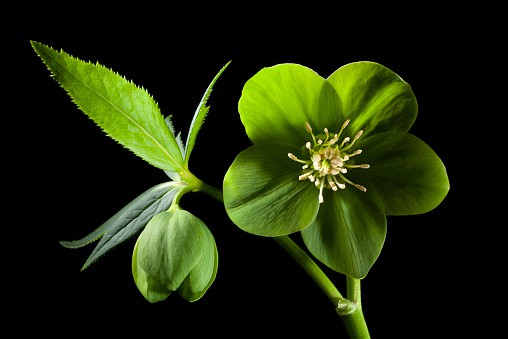Lenten Roses, scientifically known as Helleborus orientalis, is a stunning evergreen perennial plant that is native to certain dry climates in Turkey and Greece. It has become popular for its delicate saucer-shaped flowers and its ability to bring an early bloom of color to gardens after the winter months. These flowers are particularly associated with the Christian season of lent, making them a popular choice to brighten up gardens during this period.
Family
Lenten Roses belong to the Helleboraceae family, which is a small family of flowering plants that has around 17 genera and 500 species. They are often referred to as ‘Christmas roses’ due to their resemblance to a rose and their association to the Christmas holidays. They are found in temperate regions in both hemispheres and also in some tropical regions.
Plant Type
Lenten Roses are classed as a perennial plant, which means that they live for more than two years and survive a cold and frosty winter. Unlike annuals and biennials, which have a shorter lifespan and will die after the winter season, perennials come back the following spring and flower year after year without needing to be replanted.
Mature Size
The mature size of a Lenten Rose usually ranges from 10 to 25cm in height and from 15 to 45cm in width.
Sun Exposure
Lenten Roses prefer partial or full shade, meaning that they should not get more than eight hours of direct sunlight a day. If the plant is kept in too much shade it is likely not to flower; however, if it is grown in too much direct sunlight, the leaves may turn yellow and become scorched.
Soil Type
Lenten Roses will thrive in a fertile, well-drained soil. The ideal pH level is between 5.5 and 7.2. It is important to amend or mix in organic matter, such as peat moss, or composted manure, to improve the soil structure, drainage, and fertility. It’s also important to make sure the soil stays moist but is not soggy.
Soil pH
Lenten Roses prefer neutral soils with a pH range of 5.5-7.2. They will not tolerate acidic or alkaline soils, as this will affect their growth and development.
Bloom Time
Lenten Roses bloom in early spring, which makes them a wonderful choice for a garden that needs an injection of color after winter. The flowers usually last for up to two months.
Flower Color
The flowers come in a variety of colors, from white to dark maroon, and a mixture of pink, yellow, and red-purple shades.
Hardiness Zones
Lenten Roses are hardy in USDA Hardiness Zones 4 through 9.
Native Area
Lenten Roses is native to dry climates in Turkey and Greece.
How to Plant
Lenten Roses prefer partial to full shade, and will thrive in a moist, but well-drained soil with a pH level between 5.5 and 7.2. Before planting, make sure to enrich the soil with an organic matter, such as peat moss, to improve drainage and fertility. It is also important to choose a location that has some protection from winds. Plant the Lenten Roses into prepared holes, and make sure not to plant them too deeply. Water the plants to settle the soil, and water regularly after that to ensure that the ground remains moist but not soggy.
How to Grow Lenten Roses
To ensure that your Lenten Roses thrive, it is essential to provide them with the right amount of sun, temperature, water, soil, and fertilizer.
Sun Exposure
Lenten Roses should be grown in partial to full shade, as they will struggle if they get too much direct exposure to the sun. The maximum amount of direct sunlight should not exceed eight hours a day.
Temperature
The ideal temperature for Lenten Roses is between 45-85°F (7-29°C), with cooler temperatures better for flower production.
Water
Lenten Roses should be watered regularly and thoroughly, but it’s important to not over-water them as this can lead to root rot. The soil should be kept moist but not soggy.
Soil
Lenten Roses prefer moist, well-drained soil that is enriched with organic matter. The soil should also have a pH between 5.5 to 7.2.
Fertilizer
Fertilizing your Lenten Roses is essential in order to ensure that they thrive. Use a balanced fertilizer in the spring, and then again in midsummer when the flowers start to form.
Meaning and Symbolism
As their name suggests, Lenten Roses are closely associated with the Christian season of Lent. They were seen as a symbol of hope and the promise of new beginnings, as the period between Ash Wednesday and Easter Sunday marks the beginning of the Christian liturgical calendar and the celebration of the resurrection of Jesus.
The symbolism behind the Lenten Rose is also closely linked to the Greek myth about Helleboros, a young prince who was killed by serpents sent by the gods. His grieving sisters, finding no comfort from the gods, offered the flowers in his memory. As a result, the Lenten Rose became a symbol of comfort and peace, and can be seen as a reminder of the everlasting beauty of life.
History, Mythology and Religious Significance
Lenten Roses have been important symbols in Christian religion for centuries. Known for escaping the curse of death in the Garden of Eden, they have been associated with the idea of resurrection and hope. They also symbolize the life of Jesus Christ and are seen as a reminder of his death, burial and resurrection.
In Greek mythology, the story of Helleborus is closely associated with the Lenten Rose. Helleboros was a young prince who was born with a divine power that proclaimed him as the heir of the kingdom of Thebes. In response to his father’s fear of his power, the gods sent the seven deadly serpents to kill him. His grieving sisters, finding no comfort in the gods, offered the flowers in his memory, and thus the flower became a symbol of comfort and peace.
The symbolism associated with the Lenten Rose has been carried through the ages and has been used to represent the struggle between death and life, and of the promise of new life and hope. To this day, these flowers are still associated with the Christian season of Lent, serving as a reminder of the joy and promise of resurrection in the face of darkness and death.
Flower Varieties and Their Defining Characteristics
Lenten Roses come in a variety of different shapes, sizes, and colors, from white to dark maroon. Each variety has unique defining characteristics that make it stand out from the other varieties. Here we list some of the most popular varieties and their key features.
- Helleborus orientalis ‘Jacob’
This stunning variety has deep-maroon or purple blooms with orange anthers and is one of the most popular Lenten Rose varieties. It is hardy in USDA Hardiness Zones 4 to 9 and has a mature size of 10-15 cm in height and 25-45 cm in width. - Helleborus orientalis ‘Ivory Prince’
This variety has ivory-white flowers with variation in shades of pink and purple, and is quite dramatic with its contrast between its petals and sepals. It is frost hardy in USDA Hardiness Zones 4 to 10 and can reach a mature size of 10-15 cm in height and 25-45 cm in width. - Helleborus orientalis ‘Cherry Sunrise’
This variety has brilliant single cherry-red blooms with a white center, making it a very unique and eye-catching variety. It is cold hardy in USDA Hardiness Zones 4 to 10 and can reach a mature size of 10-15 cm in height and 25-45 cm in width.
How to Pot and Repot Lenten Roses
Potted Lenten Roses require special care to ensure that they stay healthy and thrive, and this should be done in the spring when the plants begin to emerge from dormancy. First, choose a pot that is large enough for the plant to grow in and has adequate drainage. Use a potting mix that is specially designed for growing Helleborus plants. Make sure not to pack the soil too tightly and water your plants thoroughly.
After the initial planting period, it is important to repot your Lenten Roses every two to three years. When the roots begin to fill the pot, it is time to repot the plants. First, take the plant out of the pot and place it in a larger one. In the new pot, use the same mix of potting soil, and make sure not to pack the soil too tightly. Water the plants after they have been repotted and place them back in the same position and light where they were originally planted.
How to Prune
Pruning Lenten Roses is essential for ensuring that they stay healthy and look their best. Lenten roses need to be pruned on a regular basis to remove dead and dying flowers and foliage. Prune back overgrown stems that have become lanky or to prevent the spindly growth of new stems. Pruning will also help to invigorate the growth of new and more vigorous stems, leaves, and flowers.
The best time to prune is late spring after the flowers have stopped blooming. Start by removing dead and damaged stems, leaves, and flowers, and then slowly cut back the other stems as needed. Avoid pruning all the way down to the ground and make sure to keep some flowers and foliage at the center of the plant; this will ensure that the plant remains healthy and regrows quickly.
How to Propagate
Propagating Lenten Roses can help to increase their populations and create larger gardens with many varieties of this flower. It is often the most preferred method of propagation as it is cost-effective and can create new plants that are genetically identical to the original.
The propagation process is relatively simple and requires minimal effort. The best time to propagate is in the late summer or early fall when the plants start to go dormant. Start by digging up the entire plant with a shovel, and then cutting the stem with a pair of sharp garden shears. Make sure to follow the natural shape of the stem and avoid making any rough cuts. It is important to make sure to leave at least 10 cm of stem on the plant when cutting.
Next, replant the stem into a shallow hole filled with a moist and well-draining soil mix. It is important to note that propagated Lenten Roses will take a few years before they start flowering.
Common Pests and Diseases
Lenten Roses are mainly susceptible to fungal diseases and some common pests, such as aphids, spider mites, slugs, and snails. The best way to prevent the spread of disease and prevent pest infestations is to ensure the soil is kept moist and well-drained. It is also important to keep the plants free from debris and to provide adequate air circulation.
Fungal diseases, such as powdery mildew, can be treated with a fungicide. Aphids and spider mites can be controlled with insecticidal soap or neem oil, while slugs or snails can be treated by setting out traps, such as beer trays or copper boards.
Frequently Asked Questions
Q: When is the best time to plant Lenten Roses?
A: The best time to plant Lenten Roses is in the late summer or early fall, when the plants have finished flowering and are going into a period of dormancy.
Q: Do Lenten Roses require a lot of maintenance?
A: Lenten Roses generally have low maintenance requirements and only require regular watering and pruning.
Q: What is the ideal temperature for Lenten Roses?
A: The ideal temperature for Lenten Roses is between 45-85°F (7-29°C), with cooler temperatures better for flower production.
Table Fact Sheet
| Information | Value |
|---|---|
| Family | Helleboraceae |
| Plant Type | Perennial |
| Mature Size | 10-25 cm H, 15-45 cm W |
| Sun Exposure | Partial – Full Shade |
| Soil Type | Moist, Well-Drained |
| Soil pH | 5.5 – 7.2 |
| Bloom Time | Early Spring |
| Flower Color | White – Dark Maroon |
| Hardiness Zones | 4 – 9 |
| Native Area | Turkey & Greece |
What we love from Amazon this week
Buy these wonderful flowers directly from Amazon:















